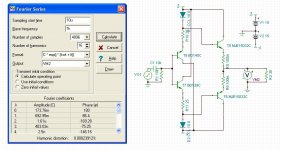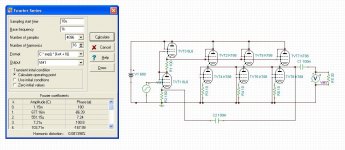Ed's point is that a sim is nice, but real pieces of silicon, carbon, and copper may not give you what the sim predicts. RM's circuit performance as a real, built item is outstandingly good. Makes me want to try to do better using vacuum tubes...😀
Ed's point is that a sim is nice, but real pieces of silicon, carbon, and copper may not give you what the sim predicts. RM's circuit performance as a real, built item is outstandingly good. Makes me want to try to do better using vacuum tubes...😀
Might not!!!??? I have some simulated amplifiers that are so close to perfect it is scary. Of course when you build them they don't come close. Then after you tweak in all the real values they still don't!
Reminds me of the internet dating beauty....
Ed's point is that a sim is nice, but real pieces of silicon, carbon, and copper may not give you what the sim predicts. RM's circuit performance as a real, built item is outstandingly good. Makes me want to try to do better using vacuum tubes...😀
I fully realize that. So, even if it's twice as much distortion, we're still talking 0.0004%. OK, make it ten times as bad... 0.002%... big hoop dee doo.
I'm looking at peltier devices for cooling... hahaha.
You wanna do this with tubes?!?!? Your headphone amp is going to double as a space heater.
You wanna do this with tubes?!?!? Your headphone amp is going to double as a space heater.
Can't deny THAT. 😀
Dirk, I know that DBs work very well - already tried a simple unitary gain DB buffer (open-loop: there's more than one way to do it... 😀) with CCS on input bjt emitters and CFPs on output: it rocks.
Nevertheless, I'm afraid I can't get the point. I mean: you can build the DB you simmed, measure it, listen to it and then - if it works well and _as expected_) eventually submit it to Janneman's LA. Then someone will pop up and say: Damn, why another discrete DB? Wht not a 49600? Why not a simpler power follower with an active load...? There's more than one way to do it (yeah, I'm a PERL fan...), and probably my way is different from yours or Richard's - to me electronic design is a matter of good engineering practices * and * personal taste: as long as the former are obeyed...
L.
Nevertheless, I'm afraid I can't get the point. I mean: you can build the DB you simmed, measure it, listen to it and then - if it works well and _as expected_) eventually submit it to Janneman's LA. Then someone will pop up and say: Damn, why another discrete DB? Wht not a 49600? Why not a simpler power follower with an active load...? There's more than one way to do it (yeah, I'm a PERL fan...), and probably my way is different from yours or Richard's - to me electronic design is a matter of good engineering practices * and * personal taste: as long as the former are obeyed...
L.
Can't deny THAT. 😀
Sy, this is for you. Enjoy.
Attachments
Dirk, I know that DBs work very well - already tried a simple unitary gain DB buffer (open-loop: there's more than one way to do it... 😀) with CCS on input bjt emitters and CFPs on output: it rocks.
Nevertheless, I'm afraid I can't get the point. I mean: you can build the DB you simmed, measure it, listen to it and then - if it works well and _as expected_) eventually submit it to Janneman's LA. Then someone will pop up and say: Damn, why another discrete DB? Wht not a 49600? Why not a simpler power follower with an active load...? There's more than one way to do it (yeah, I'm a PERL fan...), and probably my way is different from yours or Richard's - to me electronic design is a matter of good engineering practices * and * personal taste: as long as the former are obeyed...
L.
Well, that's why I will never submit it to a magazine... 😀
I was just playing around. Someone mentioned the idea of doing something great with a buffer with as few transistors as possible. So, thus the gauntlet was thrown down.... at least I had the guts to rise to the challenge. What's your circuit that meets those requirements? Can you show one? Come on, I'm waiting... Do you have a SE mosfet circuit lying around that sims good? Ha, I bet Mr. Pass can come up with something fantastic with ONE transistor... HAHAHA. Me, I'm not that talented.
Sy, this is for you. Enjoy.
If you're trying to do it the most inefficient way possible, that will certainly work. 😀
The throw down is for a Gain stage -- DA -- the Diamond Amplifier. The DB was invented and patented by R. Baker of MIT and first presented at IEEE conference in 1963.
Dirk, I know that DBs work very well - already tried a simple unitary gain DB buffer (open-loop: there's more than one way to do it... 😀) with CCS on input bjt emitters and CFPs on output: it rocks.
Nevertheless, I'm afraid I can't get the point. I mean: you can build the DB you simmed, measure it, listen to it and then - if it works well and _as expected_) eventually submit it to Janneman's LA. Then someone will pop up and say: Damn, why another discrete DB? Wht not a 49600? Why not a simpler power follower with an active load...? There's more than one way to do it (yeah, I'm a PERL fan...), and probably my way is different from yours or Richard's - to me electronic design is a matter of good engineering practices * and * personal taste: as long as the former are obeyed...
L.
BTW - the 49600 thd is very high... it must be used within the feedback loop of an op amp to get thd down. Also it cant put out great performance into 30 ohms. Note: the headphone Amplifier is not a buffer.
Last edited:
The throw down is for a Gain stage...
An externally hosted image should be here but it was not working when we last tested it.
😎
se
You win !!
The throw down is for a Gain stage -- DA -- the Diamond Amplifier. The DB was invented and patented by R. Baker of MIT and first presented at IEEE conference in 1963.
Let's put it this way -- so as to not be personal --> is there a topology that is better than a Diamond Amplifier topology? Better in all the ways I mentioned.

Let's put it this way -- so as to not be personal --> is there a topology that is better than a Diamond Amplifier topology? Better in all the ways I mentioned.

Can you post the goals for your gain stage again please? How much gain do you want in to what kind of load over what kind of bandwidth at what thd?
Ed's point is that a sim is nice, but real pieces of silicon, carbon, and copper may not give you what the sim predicts. RM's circuit performance as a real, built item is outstandingly good. Makes me want to try to do better using vacuum tubes...😀
In other words you believe that simulation always shows better than real performance, obviously you havent always simulated your circuits. In many cases the real pieces of silicon perform better than simulation. This all depends on the models which in many cases are optimistic which is a sad affair but when done properly it will surprise you. Even among Bob Cordells models I find some optimistic values but its understandable in light of factory production tolerances and the time required to get these models to match the real silicon.
Sometimes the results goes the other way though.
Last edited:
In other words you believe that simulation always shows better than real performance
I can't find the post where I said that. Can you provide a link?
Guys, we're talking about an open-loop small-power buffer capable of 0.001% THD into 30 ohm - it seems there's quite a lot of good engineering behind these figures...
L.
This is easily achieved, Im dumfounded when you make it seem likes its a miracle or something only known to a select few or something. Dirkwright has shown you the way, anything else youd like to improve on it, faster settling, less power consumption and higher efficiency or perhaps even better load handling capability, I can show you how its done if youd like.
Last edited:
- Home
- Amplifiers
- Headphone Systems
- Marsh headphone amp from Linear Audio

